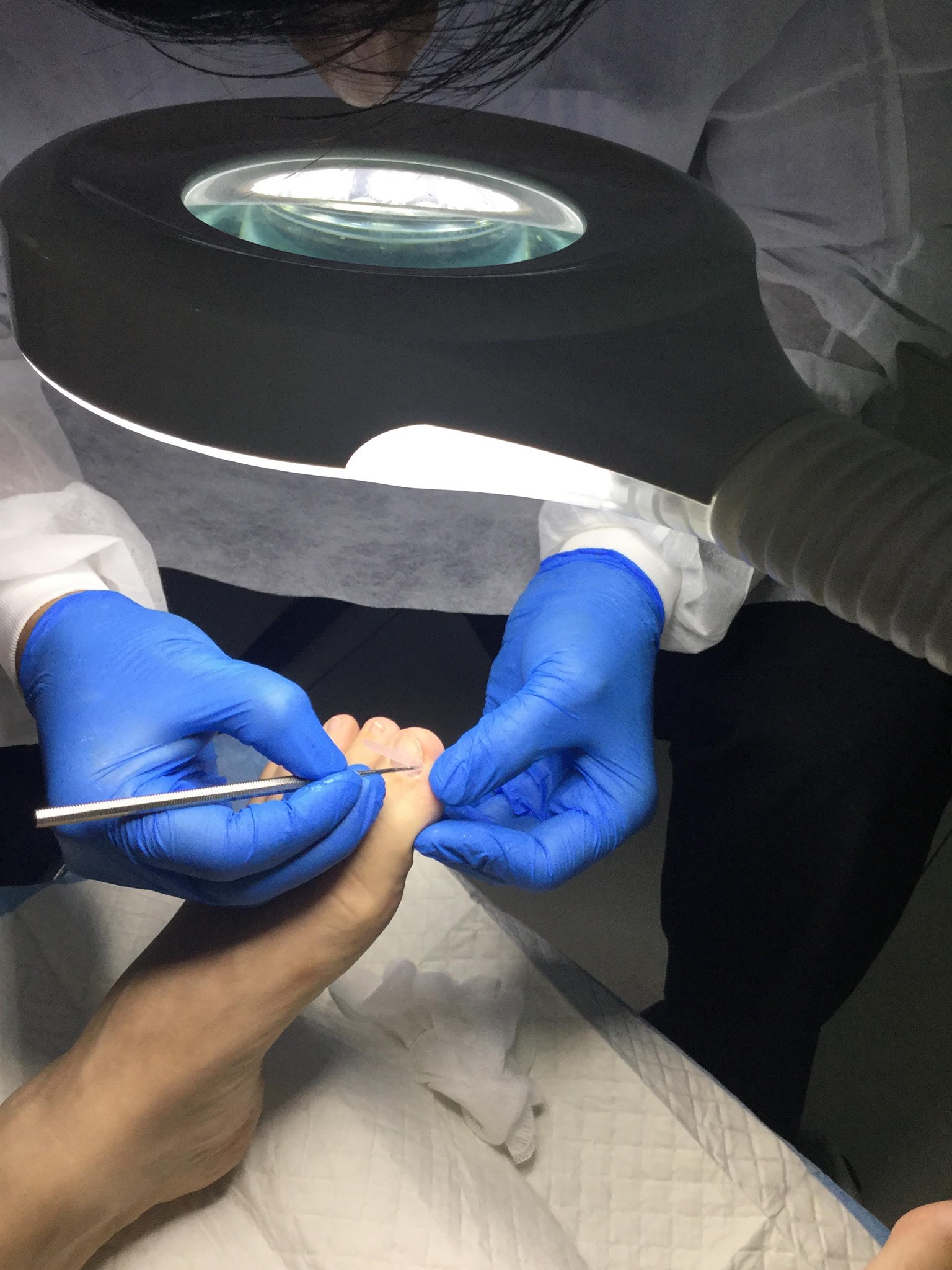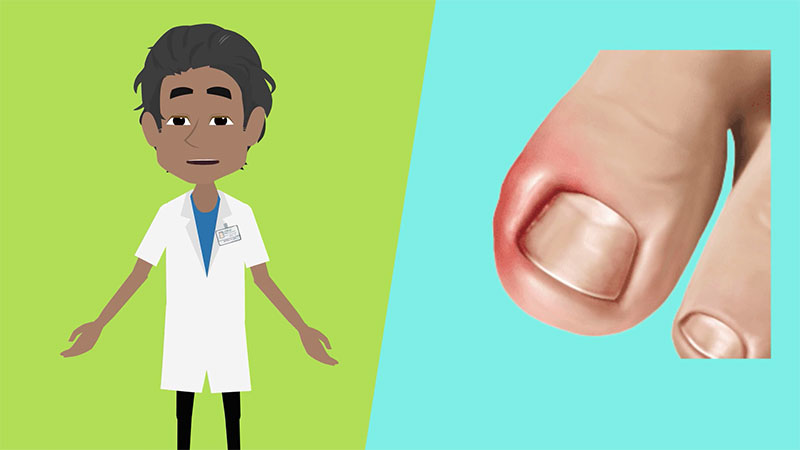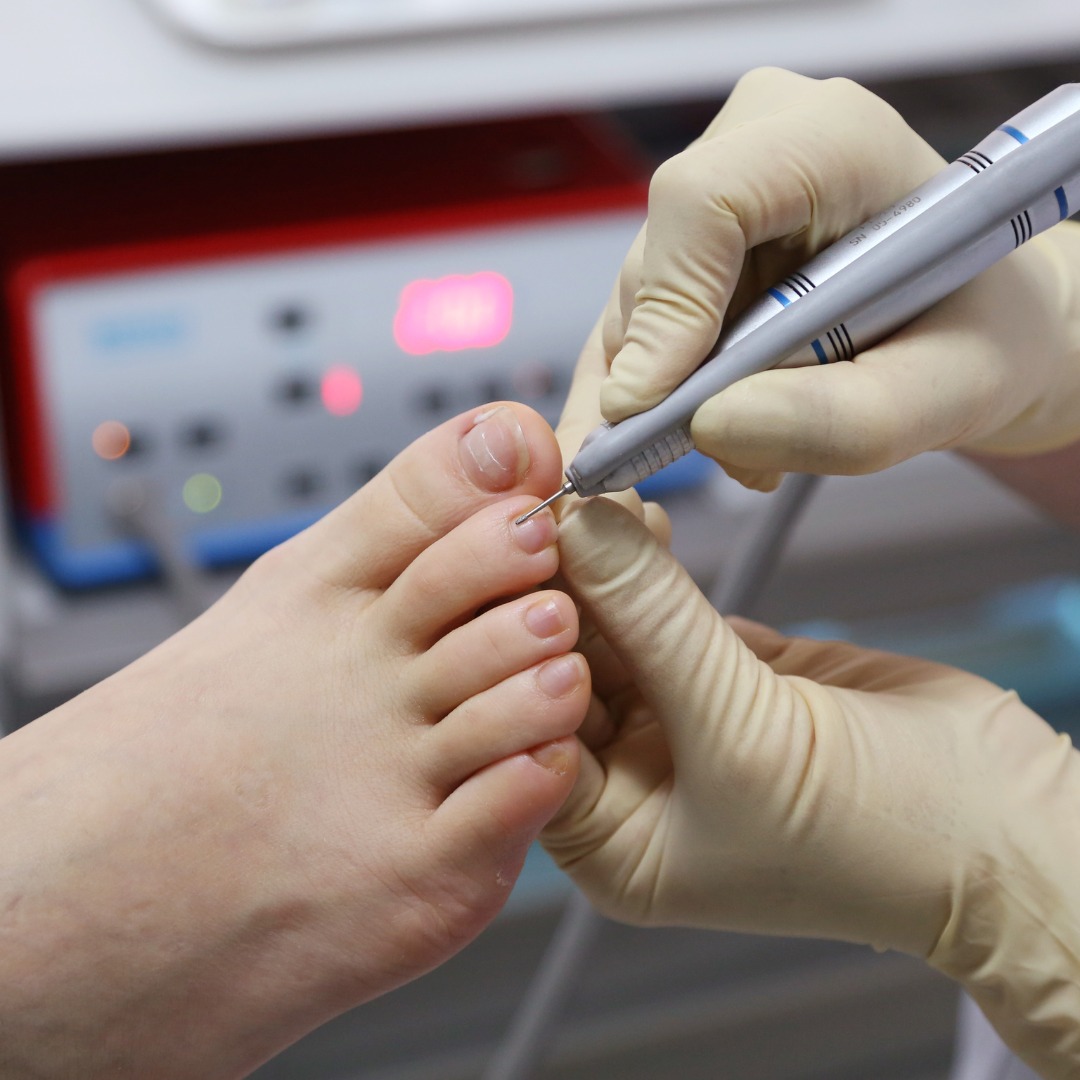Effective Treatment Options for Ingrown Toenails
Imagine walking on a sandy beach, the gentle waves lapping at your feet, but every step feels like you’re trudging through a patch of thorns. This is the painful reality for anyone suffering from an ingrown toenail. While a seemingly small issue, an ingrown toenail can bring about substantial discomfort and, if left untreated, lead to more severe complications. In this blog, we’ll dive into effective treatment options for ingrown toenails.
Understanding Ingrown Toenails: Causes and Symptoms
Ingrown toenails are a common yet often painful condition that occurs when the edges of a toenail grow into the surrounding skin, causing discomfort and potential infection. This condition typically affects the big toe, although it can occur on other toes as well. Understanding the causes and symptoms of ingrown toenails is crucial for effective treatment and prevention. Several factors contribute to the development of ingrown toenails, including improper nail trimming, where nails are cut too short or rounded at the edges, causing them to grow into the skin. Additionally, wearing tight-fitting shoes that apply excessive pressure on the toes can exacerbate the problem, as can injuries to the toe or hereditary factors that predispose some individuals to this condition.
Recognizing the symptoms of ingrown toenails early can prevent further complications. Initially, you might notice tenderness or pain along the side of the nail where it meets the skin. As the condition progresses, the affected area may become red, swollen, and warm to the touch, indicating inflammation. In some cases, the skin around the nail may become infected, leading to pus formation and increased pain. These symptoms not only cause discomfort but can also impact your daily activities, making it essential to address them promptly. If left untreated, ingrown toenails can lead to more severe infections and even necessitate surgical intervention.
Early recognition and treatment of ingrown toenails are vital for preventing complications. Simple measures, such as soaking the foot in warm water and practicing proper nail trimming techniques, can alleviate symptoms and encourage healing. Wearing comfortable shoes with ample toe space is another preventative strategy to reduce pressure on the toes. In more severe cases, medical intervention may be necessary, such as lifting the nail or partial removal to relieve pain and prevent recurrence. By understanding the causes and symptoms of ingrown toenails, individuals can take proactive steps to manage and prevent this condition, ensuring both comfort and foot health.

Treatment Options for Ingrown Toenails
Simple Home Remedies for Immediate Relief
Ingrown toenails can be a painful nuisance, but simple home remedies can offer immediate relief and help prevent further discomfort. One of the most effective methods is soaking the affected foot in warm, soapy water for 15 to 20 minutes several times a day. This not only softens the skin and nail but also reduces swelling and alleviates pain. Adding Epsom salt to the soak can enhance its soothing effects, promoting healing and reducing inflammation. After soaking, gently massaging the side of the nail can help in redirecting its growth, potentially preventing it from digging further into the skin.
Another simple yet effective remedy involves the careful trimming of the toenail. Trim the nail straight across, avoiding rounded edges that can exacerbate the problem. If the nail edge is sharp or already ingrown, gently lift it with a piece of cotton or dental floss to relieve pressure and encourage proper growth. This should be done cautiously to avoid causing additional injury or infection. Applying a topical antibiotic ointment after trimming can help prevent infection, while also soothing the irritated skin. It’s also beneficial to wear open-toed or loose-fitting shoes to reduce pressure on the affected area, allowing it to heal more effectively.
In addition to these remedies, maintaining good foot hygiene plays a crucial role in managing ingrown toenails. Regularly washing and thoroughly drying your feet can prevent bacteria buildup and reduce the risk of infection. Keeping your toenails properly trimmed and avoiding tight footwear are also key preventive measures. If home remedies do not alleviate the symptoms or if signs of infection appear, such as increased redness, swelling, or pus, it is important to seek professional medical advice. Early intervention can prevent more severe complications, ensuring both immediate relief and long-term foot health.
The Role of Proper Footwear in Prevention
Proper footwear is a vital component in preventing ingrown toenails, a common and often painful condition. Wearing shoes that fit well and provide adequate space for your toes is essential to avoid the unnecessary pressure that can lead to toenails growing into the surrounding skin. Tight or ill-fitting shoes compress the toes, increasing the likelihood of nails digging into the skin and causing irritation or infection. Opting for shoes with a wide toe box allows for natural toe splay and minimizes the risk of developing ingrown toenails. This simple change in footwear choices can significantly reduce discomfort and support overall foot health.
Beyond providing ample space, selecting shoes with supportive features can also help prevent ingrown toenails. Shoes with good arch support and cushioning can distribute weight evenly across the foot, reducing pressure on the toes. This is particularly important for individuals who stand for extended periods or those who engage in activities that exert additional force on the feet. Additionally, footwear made from breathable materials can help maintain a healthy foot environment, minimizing moisture buildup that can contribute to skin issues and infections. Prioritizing both comfort and function in your footwear choices goes a long way in safeguarding against ingrown toenails.
Incorporating regular foot care practices alongside choosing the right footwear enhances prevention efforts. Routine inspection of your feet and proper nail trimming, where nails are cut straight across and not too short, complement the benefits of proper footwear. It’s also advisable to avoid wearing high heels or pointed shoes frequently, as these styles can exacerbate toe crowding and increase the risk of nail problems. By being mindful of your footwear choices and adopting a proactive approach to foot care, you can effectively prevent ingrown toenails, ensuring your feet remain healthy and comfortable.
Trimming Techniques: Cutting Nails the Right Way
Proper toenail trimming is a crucial step in preventing the painful condition of ingrown toenails. One of the most effective techniques is to cut the nails straight across rather than curved at the edges. This method discourages the nails from growing into the skin, a primary cause of ingrown toenails. It’s important to use clean, sharp nail clippers and avoid cutting nails too short, as overly trimmed nails can increase the risk of them embedding into the surrounding skin. By maintaining a moderate length and a straight edge, you help ensure the nail grows over the skin rather than into it.
In addition to the shape and length of the nail, the timing of your trimming routine also plays a significant role. It is advisable to trim toenails after a shower or bath when they are softer and less likely to crack or splinter. This is particularly helpful for those with thicker nails, as it allows for a cleaner and more precise cut. Regular maintenance is key, so establishing a consistent trimming schedule can prevent nails from growing too long and curving downward. This practice not only helps in preventing ingrown toenails but also supports overall foot hygiene and health.
Moreover, adopting good trimming habits can be complemented by other preventive measures to protect against ingrown toenails. Ensuring that footwear provides enough room for your toes and does not apply excessive pressure can further aid in prevention. For individuals who are prone to ingrown toenails, using a nail file to gently smooth sharp edges after trimming can reduce the risk of skin irritation. Proper trimming techniques, combined with mindful foot care and appropriate footwear choices, form a comprehensive approach to maintaining healthy toes and preventing the discomfort and complications associated with ingrown toenails.

Ingrown Toenails Treatment
When Home Remedies Aren’t Enough: Medical Treatments
When home remedies fall short in alleviating the discomfort of ingrown toenails, seeking professional help for ingrown toenails becomes essential. Medical intervention often starts with a thorough examination by a healthcare provider to assess the severity of the condition. This evaluation helps in determining the most suitable treatment option. For mild to moderate cases, a physician may recommend lifting the nail and placing a splint or cotton under it to guide its growth away from the skin. This method helps relieve pressure and promotes natural nail growth, reducing the risk of further irritation and infection.
For more severe or persistent cases, medical treatments may involve partial nail removal or a procedure known as a nail avulsion. In this process, the doctor numbs the toe and removes a portion of the nail that is causing the problem. This treatment is highly effective and provides immediate relief from the pain associated with ingrown toenails. In some cases, a chemical solution may be applied to the nail bed to prevent the regrowth of the problematic nail section. This is often considered when ingrown toenails are a recurrent issue. Such procedures are typically quick and performed on an outpatient basis, ensuring minimal disruption to daily activities.
Post-procedure care is critical for ensuring successful healing and preventing recurrence. Patients are usually advised to keep the affected area clean and dry, apply prescribed antibacterial ointments, and avoid tight-fitting shoes during the recovery period. Follow-up visits may be necessary to monitor healing and address any concerns. While medical treatments are highly effective, they also underscore the importance of proper foot care and early intervention. Consulting with a healthcare professional not only provides relief but also equips individuals with personalized advice to manage and prevent future occurrences of ingrown toenails.
Tips for Long-Term Prevention
Preventing ingrown toenails in the long term requires a proactive approach that combines consistent foot care practices with thoughtful lifestyle adjustments. One of the most effective strategies is regular and proper toenail trimming. Nails should be cut straight across and not too short to avoid them growing into the skin. It is also beneficial to use clean, sharp nail clippers and trim nails after a shower when they are softer and easier to cut. Establishing a routine trimming schedule can help maintain optimal nail length and shape, significantly reducing the risk of ingrown toenails.
In addition to trimming practices, choosing the right footwear plays a vital role in prevention. Shoes should have a wide toe box to allow the toes ample room to move freely without being pinched. Tight or ill-fitting shoes can increase pressure on the toes, leading to nails growing into the skin. Opting for footwear with good arch support and cushioning distributes weight evenly and minimizes toe pressure, particularly for those who spend long hours on their feet. It’s also advisable to avoid frequently wearing high heels or pointed shoes that can exacerbate toe crowding and contribute to nail issues.
Beyond these measures, maintaining overall foot health is essential for preventing ingrown toenails. Keeping feet clean and dry helps prevent infections that could worsen the condition. Regularly inspecting feet for early signs of problems, such as redness or swelling around the toenails, allows for prompt action before issues become severe. Engaging in foot exercises to improve circulation and strength can also be beneficial. By integrating these preventative tips into daily routines, individuals can effectively safeguard against ingrown toenails, ensuring long-term foot health and comfort.
Knowing When to Seek Professional Help
Recognizing the signs and symptoms that necessitate professional medical help for ingrown toenails is crucial for effective treatment. While minor cases can often be managed with home care, certain indicators suggest that it’s time to seek expert assistance. Persistent pain, even after employing home remedies, is a key warning sign. Additionally, if you notice increased redness, swelling, or pus around the toenail, these are symptoms of infection that require medical evaluation. Failure to address these symptoms promptly can lead to more severe complications, emphasizing the importance of professional intervention.
Timely consultation with a healthcare professional can prevent the worsening of an ingrown toenail condition. A physician can accurately diagnose the severity of the situation and recommend the most suitable treatment options. For instance, they may perform procedures such as lifting the nail or conducting a partial nail avulsion to alleviate discomfort and prevent further issues. These treatments are usually quick and performed under local anesthesia, providing relief while minimizing distress. In some cases, professionals might apply treatments to reduce the likelihood of recurrence, which are not accessible through at-home care.
The benefits of seeking professional help extend beyond immediate relief. A healthcare professional can provide personalized advice on preventive measures, such as proper nail care and footwear recommendations, tailored to an individual’s specific needs. This guidance not only aids in recovery but also equips individuals with strategies to prevent future occurrences. Ultimately, consulting a professional not only addresses the immediate problem but also contributes to long-term foot health, ensuring that ingrown toenails are managed effectively and do not disrupt daily life. Prioritizing timely intervention with expert care is essential for maintaining healthy, pain-free feet.

Professional Treatment Ingrown Toenails
Conclusion
Addressing an ingrown toenail promptly is vital for avoiding pain and preventing further complications. Whether you start with home remedies or require medical treatment, the goal is to restore comfort and health to your feet. With the right care and preventive measures, you can keep ingrown toenails at bay and continue to walk through life with ease and confidence. Remember to consult a healthcare professional if symptoms persist or worsen, and prioritize proper foot care practices for long-term prevention. By taking these steps, you can enjoy happy and healthy feet for years to come. So don’t wait any longer – it’s time to take action and put an end to the discomfort caused by ingrown toenails! Your feet will thank you. Happy walking!
Flagstaff Foot Doctors: Anthony Rosales DPM
https://www.google.com/maps?cid=8835841318590452161
421 N Humphreys St, Flagstaff, AZ 86001, United States
(928) 774-4825
https://flagstafffootandankle.com/
